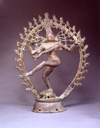| Chandralekha | |
|
Selected Objects |

India, Uttar Pradesh, Mathura area
Kushan period, 2nd century
Sandstone
H. 30 3/4 in. (78.1 cm); 1979.1
Five thousand years ago, archaic and amorphous beliefs crystallized into systems of symbology and iconography. The rich iconography of female figures-Shalabhanjika-reflect subterranean notions of fertility.
The worship of fertility goddesses goes back to the dim period of prehistory, to the culture of river civilizations-Mohenjodaro and Harappa.
Shalabhanjika is seen as a fecundity principle. Plants and leaves spring forth from her tree-like body.
She says:
Next ye gods I shall support the whole world. With the life sustaining
vegetables- Fruits and flowers. Which will grow out of my own body.
Tribals sing of her
as one who is the essence of seed:
Now as she stood Naked on the earth. Trees sprouted from her toes. And leaves Like the leaves of a wheat field.

India, Tamil Nadu
Pandya period, 8th-9th century
Granulite
H. 67 in. (170.2 cm), W. 34 3/4 in. (88.3 cm); 1979.16
This Pandya woman bears an uncanny resemblance in size, stature, and appearance to the milk woman in my neighbourhood who hustles and bustles in the dark of early morning, gets her cows and buffaloes ready, cooks grain and husk for their meal, fills their water trough, and sweeps the floor clean. She then washes their udders and sits down with a tall brass can pressed between her knees, squeezing into it the foaming, frothing warm milk. Her posture is remarkably like the Pandya woman.
The iconic postures in these stone or granite or bronze human figures spanning centuries have constant reference to as yet living practices and point to a mind-boggling visual and cultural continuity at the level of daily life and body language.
And, across millennia,
whether in the seated Pandya woman in stone relief, or the woman sitting
with her back to us in the Ajanta frescoes, or in the delicate Harappan
female figurines, we can trace this link. It comes then as no surprise
to me that such body postures now spontaneously enter my own contemporary
choreographic work. These are postures belonging to the physical vocabulary of a common cultural pool.

(Shiva Nataraja)
India, Tamil Nadu
Chola period, about AD 970
Copper alloy
H. 26 3/4 in. (67.9 cm); 1979.20
Shiva-Nataraja's ananda tandava is among the most widely depicted and interpreted compositions in the classical South Indian dance repertoire, with abundant and copious textual and sculptural references. The research work for my 1995 dance production Mahakal (Time), made me take a closer look at the Nataraja symbology for insights into this timeless image of classical equipoise. The primary question, of course was, Why did the Gods dance? For better comprehension of the form and kinetics of this 'Lord of the Dance', I studied hundreds of Nataraja icons. It became clear that while the sculptural detailing of the dancing deity had been virtually standardized and perfected into an iconographic consistency, there was exciting diversity and vari ation in the casting of the little crawling figure below Shiva's foot. It is to control and regulate this dwarf-demon, Apasmara, symbolizing egotism, ignorance, and sullen arrogance, that Nataraja dances.
In the fantasy of the ninth and tenth century bronze-casters, every Apasmara assumed a different gestural form and sculptural weight. They were able to build in an exquisite tension between the upturned, agitated, agonized figure pinned to the ground by Nataraja's balancing foot, fixed in a slippery, stubborn mood of escape, and Nataraja's expression of bliss (ananda) at fulfilling the purpose of his dance-to contain the dehumanized forces through the energy and awakening of dance, and restore balance to the universe.
The idea of integrating
this crouching, distorted, prone figure of the dwarf-demon in my choreography
was, in itself, an unconven- tional and contemporary direction for me
as it necessitated opening out an area neglected in our classical dance,
the floor level. It also enabled a direct addressing of contemporary issues
of false consciousness. Most importantly, it enabled me to present the
icon in its totality and draw attention to Shiva Nataraja's precarious
balancing act which infuses dynamic tension to his form, while celebrating
the sheer joy of combating negative energy.

India, Tamil Nadu
Chola period, early 11th century
Copper alloy
H. 35 in. (88.9 cm); 1979.19